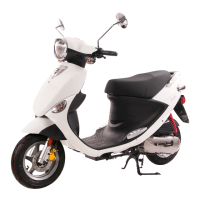
Do you have a question about the GENUINE Buddy 50 and is the answer not in the manual?
| Cooling System | Air-cooled |
|---|---|
| Fuel System | Carburetor |
| Ignition | CDI |
| Front Suspension | Telescopic fork |
| Rear Suspension | Single Shock |
| Transmission | Automatic (CVT) |
| Brakes | Front: Disc, Rear: Drum |
| Starting System | Electric / Kick |
| Top Speed | 30 mph |
| Tire Size | 10 inches |
Essential rules for safe scooter operation.
Steps to get warranty service after purchase.
Customer and dealer responsibilities for warranty claims.
Items and damages excluded from the warranty coverage.
Conditions that may interrupt or void the warranty period.
Location and description of the engine number stamping.
Location and description of the Vehicle Identification Number (VIN).
Description of the main switch positions and functions.
Controls the headlight beam between high and low.
Activates left and right turn signals.
Sounds the vehicle's horn.
Engages the starter motor to start the engine.
Indicator for Engine Management System status.
Blue indicator for high beam status.
Displays the vehicle's current speed.
Flashing green indicator for turn signals.
Check brake function, clearance, and fluid level.
Check brake function and clearance.
Check grip for smooth operation.
Check and adjust engine oil level.
Check tire pressure and wear.
Check controller/gauge cables for smooth operation.
Check brake levers for smooth operation.
Check centerstand for smooth operation.
Check body panels for proper fit.
Check fuel level.
Check operation of headlamp and signal lights.
Measure and adjust rear brake lever free play.
How the front brake lever operates.
Check for leaks from brake fluid components.
Check and refill brake fluid level.
Information on brake pad replacement.
Check throttle grip clearance and return action.
Procedures for checking and refilling engine oil.
Recommended tire pressures for front and rear.
Visual inspection for tire wear or damage.
Guideline for replacing tires based on tread depth.
Checking spark plug condition and gap.
Procedure and interval for changing gear oil.
Inspecting front brake pad wear indicators.
Checking and refilling brake fluid level and for leaks.
